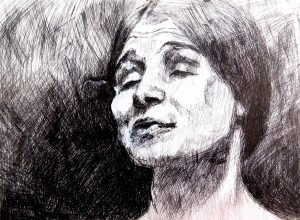Hi there! I'm Veronica Huacuja, an artist and an online art teacher. I have some good practical tips for your art process.
WOULD IT BE INTERESTING TO APPROACH DIFFERENT TOPICS IN OUR ART? I carried out this new approach to my work, and what I discovered is intriguing, mysterious, absorbing. The artwork I'm presenting results from one of those cases where art and sickness (a medical condition) gather. This is its data sheet:
Title: The Deaf Man 7
Artist: Veronica Huacuja
Medium: Acrylic on paper and digital painting
Size: 10,000 x 10,000 px, 300 dpi
Year: 2021
Collection: Human Body
SICKNESS IN ART. As I've said in some other posts, I’m an artist interested in abnormality, deformity and its effects on human life. The persons that lose one of their five senses or were born missing one of them call my interest. I explore and investigate their lives. This initial information helps me to develop my work. I created this piece with deep respect and empathy for these people.
So, following these criteria, deafness is a fearsome sickness that isolates the people that suffer it because it affects their spoken language comprehension and communication with others. Hearing loss disables a person to understand speech, reality, which cause on them–in some countries and environments–, social isolation, loneliness and stigma. (1)
"In a medical context, deafness is defined as a degree of hearing difference such that a person is unable to understand speech, even in the presence of amplification.[...] In profound deafness, even the highest intensity sounds produced by an audiometer (an instrument used to measure hearing by producing pure tone sounds through a range of frequencies) may not be detected. In total deafness, no sounds at all, regardless of amplification or method of production, can be heard." (1)
The initial challenge in this work, as a figurative artist, was to express the latter. That is to embody in a character this drama.
LET’S DEDUCE A SIGNIFICANT MEANING FROM THE ABOVE. Definitely, blending information from different fields stimulates our imagination and creativity, which reflects in the original results we might accomplish.
IMAGES OF THE TECHNICAL PROCESS OF THE ARTWORK. I’m adding some images that describe the creative process using traditional and digital techniques. You'll find them at https://www.patreon.com/posts/47080432
Visit any time:
I offer Art & Mindfulness for Business Groups. A Virtual Program for Creativity and Well-being at https://veronica.mx/artprogram
Visit any time:
My Body of Art
My Art Shop
Other Art Blogs
Art Posts and Videos at Patreon
Instagram: veronicahuacuja
TikTok: veronicafineart
Youtube: Veronica Fine Art
Email: art@veronica.mx
Thank you for visiting.



















